The Cyclades And Their Mysterious Society Lost In Time
A. Sutherland - AncientPages.com - Prehistoric Cycladic figurines carved in marble are very ancient artifacts that appeared in the Cycladic society, many centuries before the arising of the famous Minoan Civilization.
Harp player, an example of Cycladic art, at the National Archeological Museum, Athens. Image credit: Robur.q - CC BY-SA 3.0
These earliest settlers probably cultivated barley and wheat and most likely fished the Aegean for tunny and other fish. They had also accomplished sculptors in stone, as attested by significant finds of marble figurines.
What was their real meaning and purpose in the Cycladic society? How important were their enigmatic flat figurines?
A number of them survived looting and vandalism of modern times but for example, on the island Keros, they were intentionally destroyed already during ancient times.
Had this kind of action anything to do with the religious beliefs of those who discovered them on Keros Island? As far as we know, the Cycladic people did not worship the Gods of Olympus that appeared first in the 2nd millennium BC.
Was Keros a major religious center of the enigmatic Cycladic civilization some 4,500 years ago?
As we see, questions are many but answers to them are still missing.
The Cycladic Culture refers to the ancestral Greek culture of the Cycladic islands of the southern Aegean Sea, including the Neolithic (5200-3200 BC) and Early Bronze (3200-2100 BC) ages. The Cycladic culture includes the Minoan civilization.
A very advanced civilization flourished there between 3200 BC - 2000 BC and many crucial discoveries have been made on these ancient islands.
Plenty of curious artifacts - inspired by this unknown civilization - have been found on the islands but certainly, one of the most distinguishing creations of this civilization was the so-called Cycladic figurines. Their enigmatic forms possess great aesthetic power in their very simplicity.
The majority of the figures depict women.
Scientists are now researching a number of important questions regarding the unknown past of the Cycladic Islands. Among them, there is one, particularly important: why did the Cycladic Culture produce history’s largest collection of Cycladic flat-faced marble figurines?
The Cyclades is a group of approximately 220 islands located south-east of the mainland of Greece, with famous names as Santorini (Thira), Tinos, Naxos, Paros, Milos, Mykonos, Ios, and Andros.
The name “Cyclades” refers to the islands forming a circle (the name in English means: “circular islands”). These islands surround the sacred island of Delos. In Greek mythology, the god of the sea, Poseidon, was furious at the Cyclades nymphs and turned them into islands.
The name 'Cyclades' is related to Herodotus, Thucydides, and several other ancient authors.
Akrotiri ruins - first settlement 5,000 years before Christ. A center of Cycladic culture.
According to Strabo (ca. 64 B.C.-ca. A.D. 23), a Greek geographer and historian, the Cyclades formed a circle around the sacred island of Delos. We should remember, however, that the earliest recorded use of the term Cyclades dates to the 5th c. BC. Whether the 3rd millennium BC inhabitants of the Cyclades used the same or similar names for their islands is unknown.
The famous greek archeologist, Christos Tsountas (1857–1934) started his research of the mysterious Cycladic civilization in 1898 and 1899 and investigated burial sites on several islands of the Cyclades.
The Cycladic figurines made of marble originated from the best quarries in Naxos and Paros but for some millennia they have remained anonymous. It is still very little known about the mysterious Cycladic masters who created them.
Archaeologists have difficulties tracing the origins of pre-Greek civilization due to numerous and complex layers of ruins.
The Cyclades, a group of islands in the southwestern Aegean, comprises some thirty small islands and numerous islets. The ancient Greeks called them kyklades, imagining them as a circle (kyklos) around the sacred island of Delos, the site of the holiest sanctuary to Apollo.
Many of these islands are particularly rich in mineral resources—iron ores, copper, lead ores, gold, silver, emery, obsidian, and marble, the marble of Paros and Naxos among the finest in the world.
Archaeological evidence points to sporadic Neolithic settlements on Antiparos, Melos, Mykonos, Naxos, and other Cycladic Islands at least as early as the sixth millennium B.C.
In the third millennium B.C., a distinctive civilization, commonly called the Early Cycladic culture (ca. 3200–2300 B.C.), emerged with important settlement sites on Keros and at Halandriani on Syros. At this time in the Early Bronze Age, metallurgy developed at a fast pace in the Mediterranean. It was especially fortuitous for the Early Cycladic culture that their islands were rich in iron ores and copper, and that they offered a favorable route across the Aegean.
Inhabitants turned to fishing, shipbuilding, and exporting of their mineral resources, as trade flourished between the Cyclades, Minoan Crete, Helladic Greece, and the coast of Asia Minor.
The mystery of the Cycladic Culture is still unsolved.
The first version of this article was originally published on April 12, 2014
Written by – A. Sutherland AncientPages.com Staff Writer
Copyright © AncientPages.com All rights reserved. This material may not be published, broadcast, rewritten or redistributed in whole or part without the express written permission of AncientPages.com
More From Ancient Pages
-
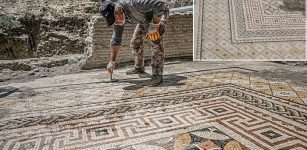 Yet Another Beautiful Roman Mosaic In Hatay, Turkey
Archaeology | Jul 14, 2022
Yet Another Beautiful Roman Mosaic In Hatay, Turkey
Archaeology | Jul 14, 2022 -
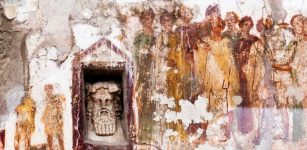 Artificial Intelligence Recreates Pompeii’s Ruined Ancient Masterpieces
Archaeology | Jul 8, 2023
Artificial Intelligence Recreates Pompeii’s Ruined Ancient Masterpieces
Archaeology | Jul 8, 2023 -
 Ghostly Appearance Of Weird Ancient City Suspended In The Sky Witnessed By Many People
Featured Stories | Jul 9, 2019
Ghostly Appearance Of Weird Ancient City Suspended In The Sky Witnessed By Many People
Featured Stories | Jul 9, 2019 -
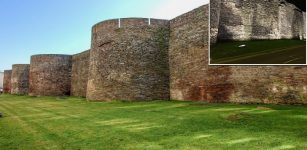 Walls Of Lugo: Finest Example Of Late Roman Fortifications – Stands The Test Of Time
Featured Stories | Sep 22, 2022
Walls Of Lugo: Finest Example Of Late Roman Fortifications – Stands The Test Of Time
Featured Stories | Sep 22, 2022 -
 Yuezhi Civilization: Ancient Nomadic People Who Once Ruled Bactria
Civilizations | Nov 29, 2018
Yuezhi Civilization: Ancient Nomadic People Who Once Ruled Bactria
Civilizations | Nov 29, 2018 -
 Gnomes – Fantastic Supernatural Creatures Knowing Secrets Of Earth Mountains Rivers And Rocks
Myths & Legends | Nov 20, 2018
Gnomes – Fantastic Supernatural Creatures Knowing Secrets Of Earth Mountains Rivers And Rocks
Myths & Legends | Nov 20, 2018 -
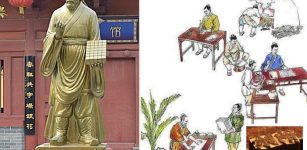 Chinese Invention: World’s First Known Movable Type Printing
Ancient History Facts | Dec 30, 2014
Chinese Invention: World’s First Known Movable Type Printing
Ancient History Facts | Dec 30, 2014 -
 Unique Flagship ‘Gribshunden’: Spectacular Discoveries
Archaeology | Oct 2, 2019
Unique Flagship ‘Gribshunden’: Spectacular Discoveries
Archaeology | Oct 2, 2019 -
 Nakanishi Ruins: One Of Japan’s Largest Ruins Discovered In Nara
Civilizations | Aug 22, 2015
Nakanishi Ruins: One Of Japan’s Largest Ruins Discovered In Nara
Civilizations | Aug 22, 2015 -
 Change Of Burial Tradition Among The People of Early Medieval Europe
Archaeology | Aug 6, 2021
Change Of Burial Tradition Among The People of Early Medieval Europe
Archaeology | Aug 6, 2021 -
 Mystery Of The Lost Biblical City Of Ai – Where Was It Located?
Biblical Mysteries | Apr 23, 2017
Mystery Of The Lost Biblical City Of Ai – Where Was It Located?
Biblical Mysteries | Apr 23, 2017 -
 Pax Mongolica: Time Of Peace And Stability That Helped To Spread Technologies And Inventions
Ancient History Facts | Mar 28, 2016
Pax Mongolica: Time Of Peace And Stability That Helped To Spread Technologies And Inventions
Ancient History Facts | Mar 28, 2016 -
 DNA Breakthrough – New Human Gene Cluster Sequence Discovered
Evolution | Nov 24, 2023
DNA Breakthrough – New Human Gene Cluster Sequence Discovered
Evolution | Nov 24, 2023 -
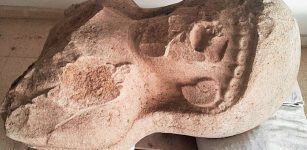 3,000-Year-Old Female Statue Unearthed In Turkey
Archaeology | Aug 11, 2017
3,000-Year-Old Female Statue Unearthed In Turkey
Archaeology | Aug 11, 2017 -
 Mysterious Utah: Prehistoric Ancient Petroglyphs Of Santa Clara River Reserve
Civilizations | Oct 2, 2018
Mysterious Utah: Prehistoric Ancient Petroglyphs Of Santa Clara River Reserve
Civilizations | Oct 2, 2018 -
 New Study: Fossils Reveal Human Ancestors’ Hearing Abilities
Human Beginnings | Sep 28, 2015
New Study: Fossils Reveal Human Ancestors’ Hearing Abilities
Human Beginnings | Sep 28, 2015 -
 5 Traces Of Ancient Ancestors That Still Exist In All Human Bodies Today
Featured Stories | Jan 23, 2023
5 Traces Of Ancient Ancestors That Still Exist In All Human Bodies Today
Featured Stories | Jan 23, 2023 -
 Remnants Of A Royal Rest House That Served As A Temporary Residence For Pharaoh Thutmose III
Archaeology | May 9, 2024
Remnants Of A Royal Rest House That Served As A Temporary Residence For Pharaoh Thutmose III
Archaeology | May 9, 2024 -
 Diver Says He Found Mysterious Underwater Ancient Tomb, Ruins And Artifacts Of An Unknown Advanced Civilization
Featured Stories | Oct 10, 2023
Diver Says He Found Mysterious Underwater Ancient Tomb, Ruins And Artifacts Of An Unknown Advanced Civilization
Featured Stories | Oct 10, 2023 -
 Oldest Cyrillic Inscriptions Dated To The Time Of King Simeon the Great – Discovered
Archaeology | May 3, 2023
Oldest Cyrillic Inscriptions Dated To The Time Of King Simeon the Great – Discovered
Archaeology | May 3, 2023



